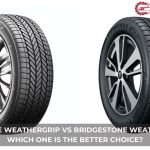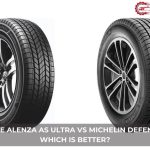When it comes to gearing up our cars for all kinds of weather, we’re often faced with a tough choice: Bridgestone WeatherPeak or Michelin CrossClimate 2? Both of these tires promise to deliver exceptional performance across various conditions, but how do they really stack up against each other?
We’ve taken a closer look at what sets these two tire giants apart. From tackling rain-slicked roads to gripping tightly on snowy days, it’s crucial to understand the strengths and weaknesses of each. Let’s dive into the world of all-weather tires and find out which one might be the best fit for your driving needs.
Overview of All-Season Tires
Diving deeper into our exploration, all-season tires stand out as versatile options for drivers seeking year-round performance without the need for switching tires as seasons change. Bridgestone WeatherPeak and Michelin CrossClimate 2 embody some of the most advanced all-season tire technologies, catering to those who prioritize safety, durability, and efficiency across various driving conditions.
All-season tires, including models from Bridgestone and Michelin, are engineered to provide balanced performance in a wide range of temperatures and weather conditions. They feature unique tread patterns and rubber compounds optimized for both warm and cold climates, making them suitable for drivers in regions where extreme weather conditions are less frequent.
One key aspect of all-season tires is their ability to offer a comfortable ride and decent handling on both dry and wet roads. The tread design of these tires typically combines elements found in both summer and winter tires; this mix allows for adequate water evacuation to prevent hydroplaning and enough flexibility to maintain grip in colder temperatures.
However, it’s important to recognize the limitations of all-season tires in severe snow and ice. While they can perform better than summer tires in light winter conditions, they do not match the performance of dedicated winter tires in more extreme scenarios. This trade-off is worth considering for drivers in areas prone to heavy snowfall and icy conditions.
Selecting an all-season tire like Bridgestone WeatherPeak or Michelin CrossClimate 2 depends on understanding the specific demands of your local climate and your expectations for tire performance across seasons. These tires offer a well-rounded solution for most drivers, balancing the need for safety and versatility throughout the year.
Key Features Compared
Building on our overview, it’s essential to spotlight how Bridgestone WeatherPeak and Michelin CrossClimate 2 tires stand against each other concerning key features. These attributes often make the difference when choosing the right all-season tire for your vehicle, aligning with your driving needs throughout the year.
Tread Life and Warranty
- Bridgestone WeatherPeak offers a generous warranty, signifying a long tread life that attests to its durability.
- Michelin CrossClimate 2, renowned for its longevity, not only matches but often exceeds expectations with exceptional wear performance.
Performance in Varied Climates
- Both tires exhibit versatility across a range of weather conditions. However, Michelin CrossClimate 2 edges ahead with superior grip and traction on snow and ice, a factor critical for those in colder climates.
- Bridgestone WeatherPeak shines in wet and dry performance, highlighted by its responsive handling and braking effectiveness.
Eco-friendliness and Fuel Efficiency
- Michelin CrossClimate 2 utilizes a unique compound and tread design that helps in reducing fuel consumption, making it a slightly more eco-friendly option.
- Bridgestone WeatherPeak, while also designed for efficiency, offers competitive but slightly less pronounced fuel-saving benefits.
- Comfort on long drives is paramount. Michelin CrossClimate 2 assures a quieter ride, minimizing road noise for a more pleasant driving experience.
- Bridgestone WeatherPeak provides a comfortable ride but tends to be a bit louder at highway speeds compared to its Michelin counterpart.
Understanding these key comparisons helps us grasp the nuances between Bridgestone WeatherPeak and Michelin CrossClimate 2 tires. It’s all about finding a match that aligns with your specific driving conditions and preferences, ensuring safety, reliability, and comfort no matter the weather.
Price Comparison
Navigating the price points between Bridgestone WeatherPeak and Michelin CrossClimate 2 tires is crucial for our decision-making. Given their unique advantages in driving performance across varied weather conditions, it’s understandable that cost plays a significant role in our final choice.
Firstly, analyzing the Bridgestone WeatherPeak, we find it positioned as a competitively priced option within the all-weather segment. Bridgestone often markets the WeatherPeak with a focus on value, balancing performance with cost-efficiency. Prices can vary depending on the size and specific model but typically range from roughly $120 to $250 per tire. This makes the WeatherPeak an appealing choice for drivers looking for reliable all-season performance without breaking the bank.
On the other hand, Michelin CrossClimate 2 tires are usually positioned at a higher price point. Reflecting Michelin’s reputation for premium quality and advanced technology, the CrossClimate 2’s cost ranges approximately from $150 to $300 per tire. This price reflects Michelin’s emphasis on providing exceptional traction in snow and ice, along with a promise of durability. Despite the higher cost, many drivers find the investment worthwhile for the enhanced safety and performance benefits, especially in challenging weather conditions.
Comparatively, while Michelin CrossClimate 2 may demand a greater initial investment, its extended tread life and robust performance in severe weather can offer long-term savings by reducing the need for frequent replacements. Conversely, Bridgestone WeatherPeak tires present a more affordable upfront cost, making them accessible for drivers focused on immediate budget considerations.
Choosing between Bridgestone WeatherPeak and Michelin CrossClimate 2, therefore, involves weighing the immediate cost against potential long-term benefits. Our preference leans towards evaluating our specific driving needs, local climate conditions, and financial plan to derive the best value proposition from our tire purchase.
User Reviews and Ratings
Transitioning from the price comparison between Bridgestone WeatherPeak and Michelin CrossClimate 2, we now delve into what users have to say about these tires. User reviews and ratings are pivotal for potential buyers, providing insights beyond specifications and price points.
Bridgestone WeatherPeak tires receive praise for their exceptional value and reliability. Many users highlight the tire’s performance in various conditions, emphasizing its grip and handling on wet roads. Comfort and noise level also score highly among drivers, with several noting a smooth ride experience. However, some reviews mention a slight compromise in snow and ice handling compared to more specialized winter tires. Ratings for Bridgestone WeatherPeak often fall in the range of 4 to 4.5 out of 5 stars across various platforms.
On the other side, Michelin CrossClimate 2 tires garner admiration for their groundbreaking all-weather capabilities. Users frequently commend the tire’s superior traction in snow and icy conditions, stressing its versatility as a year-round tire. The longevity and durability of the CrossClimate 2 are also lauded, with many drivers reporting minimal tread wear over time. Comfort is another strong suit, though a few reviews point out a marginally higher noise level compared to some competitors. Michelin CrossClimate 2 typically sees ratings from 4.5 to nearly 5 stars, reflecting its premium positioning and performance.
User reviews and ratings align closely with the initial expectations set by each tire’s design and price. Bridgestone WeatherPeak offers an attractive balance of performance and value, securing its place as a competent all-season choice. Meanwhile, Michelin CrossClimate 2 stands out for its exceptional all-weather performance and durability, justifying its higher price tag for those seeking top-tier quality. Both sets of tires have their champions among users, who appreciate their respective strengths in meeting the demands of diverse driving conditions and preferences.
Professional Opinions
We’ve explored the price comparison and user reviews for both Bridgestone WeatherPeak and Michelin CrossClimate 2 tires, revealing their strengths in value and all-weather performance, respectively. Now, we turn our attention to professional opinions to broaden our understanding of these tires’ capabilities.
Experts in the tire industry often regard Bridgestone WeatherPeak tires as a solid choice for drivers prioritizing a blend of performance, durability, and cost-effectiveness. They highlight the tire’s balanced design, which provides reliable handling and comfort in a variety of driving conditions, including light snow. Professionals also appreciate Bridgestone’s effort to offer a tire that performs well across multiple parameters without breaking the bank.
On the other hand, Michelin CrossClimate 2 tires receive commendations from professionals for their advanced technology and superior all-weather capability, especially in snow and ice. These tires are often cited for their impressive traction and safety features, which stem from Michelin’s innovative tread design and rubber compounds. The higher price tag of the Michelin CrossClimate 2 is viewed as justified by its exceptional performance and longer tread life, making it a premium choice for those who seek the utmost in safety and versatility throughout the year.
Automotive journalists, in particular, have conducted tests that demonstrate the Michelin CrossClimate 2’s slight edge in harsh winter conditions compared to the Bridgestone WeatherPeak. However, they also note that the WeatherPeak performs admirably in most scenarios and offers incredible value, making it a competitive option for the budget-conscious buyer.
Professional opinions align closely with user experiences, painting a picture of two highly capable all-weather tires that cater to different priorities. The Bridgestone WeatherPeak is celebrated for its value proposition and balanced performance, while the Michelin CrossClimate 2 is lauded for its superior all-season safety and longevity, albeit at a higher cost.
Environmental Impact
Transitioning from our discussion on performance, value, and expert ratings, we now turn our attention to the environmental impact of Bridgestone WeatherPeak and Michelin CrossClimate 2 tires. Both brands have made significant strides in reducing their environmental footprint, utilizing advanced materials and manufacturing processes.
Bridgestone focuses on sustainability through its commitment to using recycled and renewable materials. The company aims to produce tires that are 100% sustainable by 2050, incorporating recycled rubber and innovative compounds to reduce CO2 emissions during production. Bridgestone’s “Eco-Products” designation highlights tires offering reduced rolling resistance, which directly translates to lower fuel consumption by vehicles, further minimizing environmental impact.
Michelin, on the other hand, integrates its Vision Concept around the usage of bio-sourced and recycled materials, such as sunflower oil and recycled plastic bottles, in the Michelin CrossClimate 2. This tire is designed not only for superior performance but also for environmental efficiency. Michelin’s commitment to reducing carbon footprint is evidenced by its long-lasting tread life, reducing the frequency of tire replacements and therefore lessening waste. The CrossClimate 2’s lower rolling resistance also improves fuel efficiency, aligning with Michelin’s goal for a greener planet.
Both Bridgestone and Michelin contribute to environmental sustainability by investing in research and development to produce eco-friendly tires. While Bridgestone emphasizes the use of sustainable materials and the goal of creating completely sustainable tires, Michelin focuses on efficiency and longevity, aiming to reduce the overall impact of tires on the environment through advanced technology. Through these efforts, consumers who prioritize ecological factors in their tire purchasing decisions can trust that both Bridgestone WeatherPeak and Michelin CrossClimate 2 offer options that align with their environmental values.
Conclusion
We’ve explored the nuances between Bridgestone WeatherPeak and Michelin CrossClimate 2, weighing their performance, cost, and environmental impacts. Whether you’re leaning towards Bridgestone for its cost-efficiency and commendable sustainability efforts or Michelin for its superior all-weather performance and cutting-edge technology, both brands offer compelling reasons to be the top choice for your vehicle. Ultimately, the decision rests on what you value most: upfront savings and eco-friendliness or investing in advanced safety and performance. Whatever your preference, you’re well-equipped to make an informed choice that aligns with your driving needs and environmental considerations.
Related Posts:













